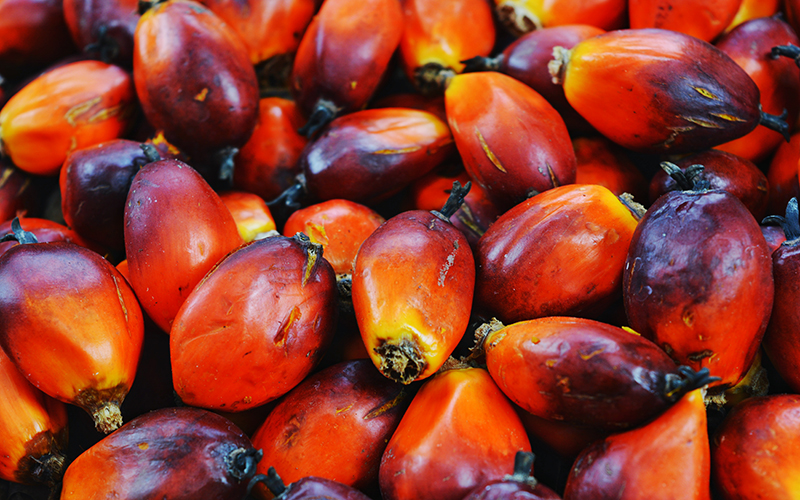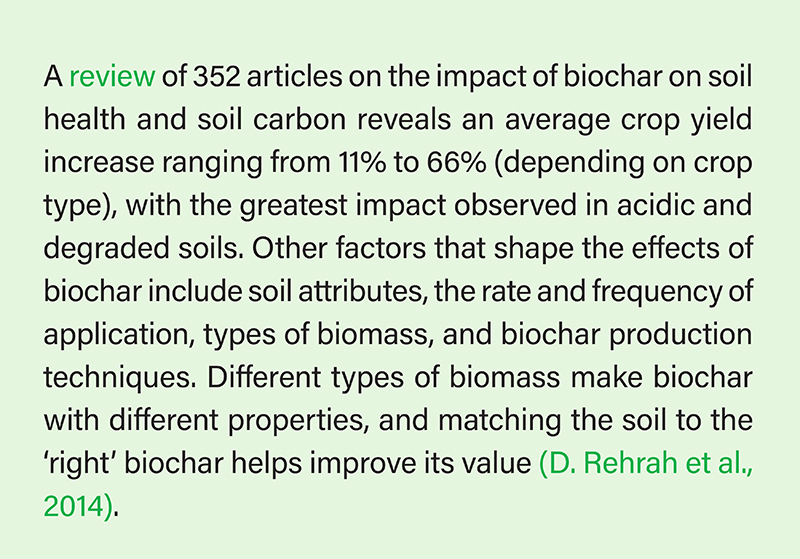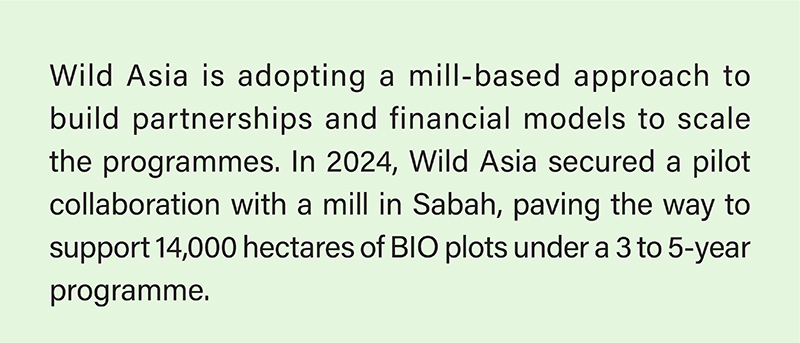Innovations in Practice: Regenerative Agriculture in Oil Palm
Using the ‘living lab’ approach, Wild Asia introduces tried-and-tested farming techniques to oil palm farmers, thereby boosting productivity and resilience and improving ecosystem health.

Agroforestry in Oil Palm
In 2023, Wild Asia introduced the Laran tree (Neolamarckia cadamba) as an integrated crop within an oil palm block to BIO farmers, following observations of other farmers in Sabah who had already implemented it. In Sabah, this indigenous, fast-growing commercial timber species has been introduced as a substitute for light hardwood dipterocarps, such as Seraya (Shorea curtisii), since the 1990s.

A study by the Sabah Forestry Department reveals that intercropping Laran and Binuang (Octomeles sumatrana) with oil palm is highly feasible. When grown in the early stages with oil palm, the trees capitalise on the unutilised sunlight before the palm canopy closure, which occurs at the age of eight to 10 years. Thus, the fresh fruit bunch (FFB) yields will not be affected by the presence of timber trees; they will decrease slightly when the palm trees are 12 years old or older, according to a 2005 study.
“Laran can be harvested within 8 to 10 years. It’s self-pruning - the lower branches fall independently, making the trees low-maintenance. Of course, when the leaves fall, they make good mulch on the ground and add organic matter to the soil,” says Wild Asia Director and Advisor, Peter Chang.
Although the farmers can fertilise the palm trees as usual, Wild Asia is trying to get farmers to apply BIO practices in this agroforestry system, Chang added. The trees have high commercial value and are used for the manufacture of plywood and other furniture products.
“For each hectare, you can plant about 100 Laran trees with about 140 oil palm trees. In today’s market price, each tree can fetch from RM600 to RM1000, so you can get RM60,000 to RM100,000,” says Chang.
In a paper titled Carbon Stock and Sequestration Potential of an Agroforestry System in Sabah, Malaysia, the researchers concluded that “converting a monoculture plantation into an agroforestry system can contribute to increased carbon storage and sequestration, although the total carbon stock depends on vegetation, tree ages, and soil management practices".
So, not only do farmers earn extra income, but they can also contribute to climate change solutions.

The Laran tree, scientifically known as Neolamarckia cadamba, is a self-pruning tree that can be harvested within 8 to 10 years.
Wild Asia has distributed 200 Laran seedlings, cultivated at the Sandakan office nursery, to the farmers. However, not everyone is in favour of intercropping Laran.
In 2013, the Kinabatangan-based small grower Kesungguhan Sumur (KS) intercropped approximately 1,500 Laran trees on 20 hectares of oil palm out of a total of 75.38 hectares. The survival rate for the Laran saplings was 70%.
“Compared to the other plot, the FFB yield is much lower for the oil palm intercropped with the Laran as they compete for nutrients with each other,” says KS owner Chin Kok Lin, who plans to harvest the Laran to cover the oil palm replanting cost when the time comes. Also, as a WAGS BIO member, KS has 3 BIO plots totalling 1.2 hectares.
“However, we only fertilised the palm trees, not the Laran ones. I’d suggest that other farmers plant Laran at the borders of the palm blocks or in a different area.”
Biochar and Carbon Removal
In 2020, Wild Asia launched a trial project to convert oil palm waste into biochar to regenerate soils, sequester carbon, and create new revenue streams for farmers. A form of charcoal produced in low-oxygen environments, biochar ‘fixes’ the carbon in plant matter into a long-term, stable form stored in soils. As a low-fertility soil amendment, biochar improves water and nutrient retention, reduces soil acidity, encourages soil microbiota, and improves crop yields.


Ithaka developed the guidelines for the Global Artisan C-Sink standards, which are endorsed by Carbon Standards International (CSI). The C-Sink certification guarantees that the biomass is sustainably and artisanally produced with Kon-Tiki-type kilns and reduces emissions in the process. C-sink credits can be sold via trading platforms to generate additional income for farmers.
For the first trial, the BIO team applied biochar to four rows of palm trees on Muharram Sompo’s farm.
“We started the first trial on Muharram’s farm as he’s our very first BIO farmer and always the first to agree to try new, ‘crazy’ ideas!” Reza adds. Midribs of palm fronds and organic waste, such as banana leaves, are burned in a steel cone-shaped kiln, and the resulting biochar is enriched with aerated compost tea before being added to the soil.
Unlike commercial biochar equipment, the Kon-Tiki kiln prototype is a low-cost option, making it accessible to smallholders with limited resources. Wild Asia also loans the kilns to farmers who are keen to produce biochar on their farms.
Baseline monitoring was done from 2020 to 2024 to track earthworm population density, tree health and soil infiltration on Muharram’s farm. The result shows the earthworm population has tripled to 107 earthworms per m² in 2024 from 32 earthworms per m² in 2020. His earthworm community is larger than a tropical rainforest’s earthworm population, which averages 68 earthworms per m². His *soil infiltration rate has increased threefold.
“Preliminary findings from a University of Tokyo study, which looks at carbon impact, show that biochar application combined with chemical-free production can reduce palm oil’s carbon footprint by as much as 30%. This info opens the way to how we can drive for lower emissions, and ultimately show how agricultural lands could be longer-term carbon sinks in the future,” says Reza.
Facts and Figures
To scale up WAGS BIO beyond the smallholder network, Wild Asia has been engaging small growers and plantations to join the regenerative farming movement.


Biochar, a form of charcoal produced in low-oxygen environments, fixes the carbon in plant matter into a long-term, stable form stored in soils.
Since 2020, Wild Asia has been collaborating with Kim Loong Resources Berhad’s Sabah-based mill and plantation. Kim Loong carved out four BIO plots totalling 5.25 hectares and one ‘control’ (conventional) plot in their Telupid estate. So far, they have adopted Stage 2 BIO methods, which include cut-and-drop, decanter cake, EFB (empty fruit bunch), and enzyme fertiliser applications.
Among the key findings from the WAGS BIO 2023 Annual Report, the Kim Loong estate BIO trial results showed potential yield increases of up to 21% within two years compared to the conventional plot.
Five case studies on the pioneer smallholder farms indicated healthier palm trees, reduced nutrient deficiencies and pest attacks, quicker soil infiltration rates, improved soil condition and notable increases in earthworm population densities within two years.
Despite the likelihood of higher manpower costs, analysis suggests a potential 7% increase in gross profit with WAGS BIO practices compared to conventional farming. Collaborative research between Wild Asia and the UK-based University of York involving 40 WAGS farms in Sabah shows that sustainable management practices do not reduce oil palm yields on smallholder farms.
Towards the New Normal
“Fundamentally, these ‘innovative’ practices and case studies show us what palm oil could be: traceable, inclusive and nature-positive,” says Reza.

By working closely with mills, smallholders, and traders, we ensure that sustainability is not just an ideal but a practical, achievable reality that benefits both people and the environment.”

Kon-Tiki kiln is a steel cone-shaped kiln accessible to smallholders with limited resources through Wild Asia.
Sowing the Seeds
As for the smallholders, more farmers are becoming familiar with the concept of regenerative farming practices. In recent years, the BIO outreach programmes have been attracting huge interest. But the stumbling blocks remain.
“Some farmers are still resistant to change and to the labour-intensive practices with no instant financial gains,” says Chang. “And climate change issues are not a priority for older farmers.”
Not many farmers are like Muharram, who is willing to take a chance on something unconventional and stick with it for the long haul, Chang added. However, the success stories coming from pioneer farmers like Muharram and Mat Jailani are attracting more new farmers to the fold. As role models, Muharram and Mat Jailani are leading the change within the farmer networks.
“The work is relentless, but I’ve found my rhythm,” Muharram admits. “But I hope there will be more schemes to finance regeneration to attract more farmers. In the meantime, the work continues.”
Slowly but steadily, the seeds of change are taking root.
*Infiltration rates measure how well water flows to crop roots, and these measurements are used to predict erosion and assess soil health.








